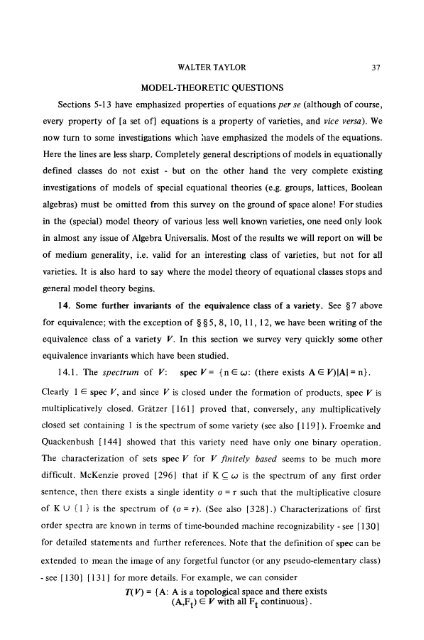Survey 1979: Equational Logic - Department of Mathematics ...
Survey 1979: Equational Logic - Department of Mathematics ...
Survey 1979: Equational Logic - Department of Mathematics ...
You also want an ePaper? Increase the reach of your titles
YUMPU automatically turns print PDFs into web optimized ePapers that Google loves.
WALTER TAYLOR 37<br />
MODEL-THEORETIC QUESTIONS<br />
Sections 5-13 have emphasized properties <strong>of</strong> equations per se (although <strong>of</strong> course,<br />
every property <strong>of</strong> [a set <strong>of</strong>] equations is a property <strong>of</strong> varieties, and vice versa). We<br />
now turn to some investigations which have emphasized the models <strong>of</strong> the equations.<br />
Here the lines are less sharp. Completely general descriptions <strong>of</strong> models in equationally<br />
defined classes do not exist - but on the other hand the very complete existing<br />
investigations <strong>of</strong> models <strong>of</strong> special equational theories (e.g. groups, lattices, Boolean<br />
algebras) must be omitted from this survey on the ground <strong>of</strong> space alone! For studies<br />
in the (special) model theory <strong>of</strong> various less well known varieties, one need only look<br />
in almost any issue <strong>of</strong> Algebra Universalis. Most <strong>of</strong> the results we will report on will be<br />
<strong>of</strong> medium generality, i.e. valid for an interesting class <strong>of</strong> varieties, but not for all<br />
varieties. It is also hard to say where the model theory <strong>of</strong> equational classes stops and<br />
general model theory begins.<br />
14. Some further invariants <strong>of</strong> the equivalence class <strong>of</strong> a variety. See õ 7 above<br />
for equivalence; with the exception <strong>of</strong> õ õ 5, 8, 10, 11, 12, we have been writing <strong>of</strong> the<br />
equivalence class <strong>of</strong> a variety V. In this section we survey very quickly some other<br />
equivalence invariants which have been studied.<br />
14.1. The spectrum <strong>of</strong> V: spec V= (nco' (there exists AV)lAl=n).<br />
Clearly 1 6 spec V, and since V is closed under the formation <strong>of</strong> products, spec V is<br />
multiplicatively closed. Gr/itzer [161] proved that, conversely, any multiplicatively<br />
closed set containing 1 is the spectrum <strong>of</strong> some variety (see also [ 119 ] ). Froemke and<br />
Quackenbush [ 144] showed that this variety need have only one binary operation.<br />
The characterization <strong>of</strong> sets spec V for V j'nitely based seems to be much more<br />
difficult. McKenzie proved [296] that if K C_ co is the spectrum <strong>of</strong> any first order<br />
sentence, then there exists a single identity o = r such that the multiplicative closure<br />
<strong>of</strong> K tJ ( 1 ) is the spectrum <strong>of</strong> (o = r). (See also [328] .) Characterizations <strong>of</strong> first<br />
order spectra are known in terms <strong>of</strong> time-bounded machine recognizability - see [ 130]<br />
for detailed statements and further references. Note that the definition <strong>of</strong> spec can be<br />
extended to mean the image <strong>of</strong> any forgetful functor (or any pseudo-elementary class)<br />
- see [ 130] [ 131 ] for more details. For example, we can consider<br />
T(V) = (A: A is a topological space and there exists<br />
(A,F t) 6 V with all F t continuous).

















